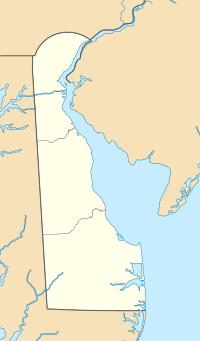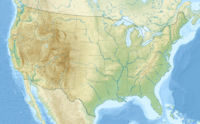Swan Creek (Mispillion River tributary) facts for kids
Quick facts for kids Swan Creek |
|
|---|---|
|
Location of Swan Creek mouth
|
|
| Other name(s) | Tributary to Mispillion River |
| Country | United States |
| State | Delaware |
| County | Kent |
| Physical characteristics | |
| Main source | outlet of Tubmill Pond about 0.5 miles south of Lynch Heights, Delaware 10 ft (3.0 m) 38°56′32″N 075°25′40″W / 38.94222°N 75.42778°W |
| River mouth | Mispillion River New Wharf, Delaware 0 ft (0 m) 38°56′14″N 075°24′11″W / 38.93722°N 75.40306°W |
| Length | 1.84 mi (2.96 km) |
| Basin features | |
| Progression | east |
| River system | Mispillion River |
| Basin size | 5.09 square miles (13.2 km2) |
| Tributaries |
|
| Bridges | DE 1, New Wharf Road |
Swan Creek is a small but important waterway in Kent County, Delaware. It flows for about 1.84 mi (2.96 km) and is a "second-order tributary." This means it's a stream that flows into a larger stream, which then flows into an even bigger river. Swan Creek eventually joins the Mispillion River.
Contents
Where Does Swan Creek Start and End?
Swan Creek begins its journey at the end of a place called Tubmill Pond. This starting point is about half a mile south of Lynch Heights, Delaware. From there, the creek flows towards the east.
The Creek's Journey to the Mispillion River
As Swan Creek travels east, it eventually reaches a town called New Wharf, Delaware. This is where Swan Creek meets and joins the larger Mispillion River. The water from Swan Creek then becomes part of the Mispillion River's flow.
What is the Swan Creek Watershed?
A watershed is like a giant bowl or area of land where all the rain and snowmelt drain into a common stream, river, or lake. The Swan Creek watershed is the entire area of land that collects water and sends it into Swan Creek.
How Big is the Swan Creek Watershed?
The Swan Creek watershed covers an area of about 5.09 square miles (13.2 km2). This means that all the rain and water that falls on this land will eventually make its way into Swan Creek. The area gets about 45.7 inches of rain each year. A small part of this watershed, about 8.8%, is covered by forests. These forests help keep the water clean.
Images for kids





